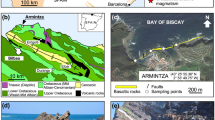Summay
A suite of potassic alkaline volcanites is spatially and temporally associated with rapakivi granites which are related to Proterozoic (1.85 to 1.40 Ga) rifting in the Beijing area. The volcanites are spread along an EW-trending 150 km long sea basin rift and the rapakivi granites were emplaced along a major EW-fault in nn adjacent uplifted region. The alkaline magmatism is comparable to the middle Proterozoic anorogenic magmatism in North America and Fennoscandia and is related to incipient breakup of the craton they intrude. The volcanic rocks and the rapakivi granites show within plate affinities. They also have similar overall REE distribution patterns that are enriched in LREE. The rapakivi granites show larger negative Eu anomalies than the volcanites. The data suggest that the rapakivi granites were crystallised from a more evolved magma than the volcanic rocks.
Zusammenfassung
Eine Serie von K-reichen, alkalischen Vulkaniten ist räumlich und zeitlich mit Rapakivi-Graniten, die mit dem proterozoischen (1.85 bis 1.40 Mia) Rifting in der Peking Region im Zusammenhang stehen, assoziiert. Die Vulkanite treten entlang eines E-W-streichenden, 150 km langen Riftbeckens auf, die Rapakivi-Granite kommen entlang einer EW Hauptstörung in einer angrenzenden Hebungszone vor. Der Alkali-Magmatismus ist mit dem mittelproterozoischen, anorogenen Magmatismus in Nordamerika und Fennoskandien vergleichbar und mit einem beginnenden Aufbrechen des Kratons ver bunden. Sowohl die Vulkanite, wie auch die Rapakivi-Granite zeigen Intraplatten-Affinität. Sie zeigen generell ähnliche SEE Verteilungsmuster, die an LSEE angereichert sind. Die Rapakivi-Granite zeigen weiters eine stärkere, negative Eu-Anomalie als die Vulkanite. Diese Daten weisen darauf hin, daß die Rapakivi-Granite aus einem höher entwickelten Magma als die Vulkanite entstanden sind.
Similar content being viewed by others
References
Anderson JL (1983) Proterozoic anorogenic granite plutonism of North America. In:Madaris LG Jr, Byers CW, Mickelson DM, Shanks WC (eds) Proterozoic geology. Geol Soc Am Mern 161: 133–154
Emslie RF (1978) Anorthosite massifs, rapakivi granites, and late Proterozoic rifting of North America. Precambrian Res 7: 61–98
Haapala I, Rämö OT (1990) Petrogenesis of the Proterozoic rapakivi granites of Finland. In:Stein HJ, Hannah JL (eds) Ore-bearing granite systems. Petrogenesis and mineralizing processes. Geol Soc Am Spec Pap 246: 275-286
Hu S, Wang (1987) The40Ar/39Ar age spectrum of Damiao anorthosites and its geological implication. In:Wu C, Sun D (eds) IGCP Project 217 Symposium on geochemistry and mineralization of Proterozoic mobile belts. Tianjin Institute of Geology and Mineral Resources, p 40 (Abstracts)
Irvine TN, Baragar WRA (1971) A guide to the chemical classification of the common volcanic rocks. Can J Earth Sci 8: 523–548
LeMaitre RW (1989) A classification of igneous and glossary of terms. Recommendations of the IUGS, subcommission on the Systematics of Igneous Rocks. Blackwell
Liu Y, wang Q, Zhao J (1978) A preliminary study based on gravity data of the crustal structure of the Peking-Tientsin area and its neighboring regions. Acta Geophys Sinica 21(1) (in Chinese with English abstract)
Lu S, Li H (1991) A precise U-Pb single zircon age determination for the volcanics of Dahongyu Formation, Changcheng System in Jixian. Bull Chinese Acad Geol Sci 22: 137–146 (in Chinese with English abstract)
Nisbet EG, Pearce JA (1977) Clinopyroxene composition in mafic lavas from different tectonic settings. Contrib Mineral Petrol 63: 147–160
Pearce JA (1982) Trace element characteristics of lavas from destructive plate boundaries. In:Thorpe RS (ed) Andesites. Wiley, New York, pp 525–547
Pearce JA, Harris NBW Tindle AG (1984) Trace element discrimination diagrams for the tectonic interpretation of granitic rocks. J Petrol 25: 956–983
Qiu J (1987) The mineral chemistry of pyroxene in Cenozoic basaltic rocks and its petrological implications. Petrology 4: 11–20 (in Chinese with English abstract)
Vorma A (dy1976) On the petrochemistry of rapakivi granites with special reference to the Laitila massif, southwestern Finland. Geol Surv Finland Bull 285: 98 pp
Wang H, Qiao X (1984) Proterozoic stratigraphy and tectonic framework of China. Geol Mag 121(6): 599–614
Xie G, Wang J (1988) A preliminary study on the emplacement age of the Damiao anorthosite complex. Geochimica 1: 13–17 (in Chinese with English abstract)
Yu J, Fu H, Zhong F, Guan M (1991) Geochemistry of a rapakivi granite suite in a Proterozoic rift trough in Beijing and its vicinity. Acta Geol Sinica 4(2): 169–186
Zhao C (1964) Geological and petrological research on rapakivi granite in Miyun, Beijing. Proceedings of the First Conference of Mineralogy, Petrology and Geochemistry sponsored by the Geological Society of China (Rock Part), pp 124-143 (in Chinese)
Zhong F (1977) On the Chinese Sinian chronology according to isotopic ages of Sinial strata in Yanshan area. Sience of China 2: 151–161 (in Chinese with English abstract)
Author information
Authors and Affiliations
Rights and permissions
About this article
Cite this article
Yu, J., Fu, H., Zhang, F. et al. Petrogenesis of potassic alkaline volcanics associated with rapakivi granites in the Proterozoic rift of Beijing, China. Mineralogy and Petrology 50, 83–96 (1994). https://doi.org/10.1007/BF01160141
Received:
Accepted:
Issue Date:
DOI: https://doi.org/10.1007/BF01160141




